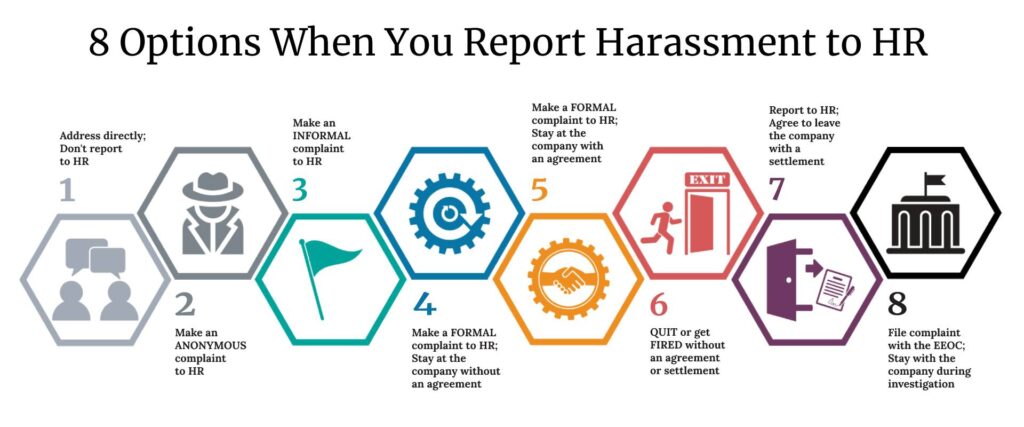Should You Report Harassment to HR?
98% of US organizations have a sexual harassment policy, and yet, 72% of victims of sexual harassment never report to HR.
– Career Builder Survey

Making the decision to report harassment or discrimination to your Human Resource department can feel risky. You have to trust the people you are reporting to; you have to trust you will be treated fairly; you have to trust their process; and you have to trust the OUTCOME will not work against you. There is a reason so many people don’t take their complaints to human resources.
If your company has a reporting process that makes it less of a risk to make a complaint, your HR representative may be your best option to find a quick resolution.
To help determine if filing a complaint with HR is a good option for you, we first offer pros and cons, followed with an options guide – 8 Options When Reporting to HR – with associated tasks, warnings, and outcomes, plus an effort/risk meter. And for those who choose to file a complaint with HR, we provide a step-by-step process to help you prepare for the complaint and investigation process.
Regardless of which direction you take, it is your energy, effort, safety and job at risk. Make the right choice for YOU.
REMEMBER
- This is a process. This issue will not be resolved quickly. It will take time.
- Your HR department represents the company’s interests first. They are looking for the best outcome for the company.
- Your HR department will manage the process.
- For your benefit, document everything! See our documentation templates HERE.
The Pros and Cons of Reporting Harassment to HR
Before you consider making a complaint to your human resource representative, ask yourself:
- What outcome do I want?
- Is my HR department able to help me achieve that outcome?
Some examples are:
- Stop the harassment/discrimination
- Put it on the record
- Get your harasser removed from your department, reporting structure or the company

Pros for Reporting to HR
- Hands the issue over to a third party to help resolve the problem
- Puts the harassment/discrimination on the record
- Potential to hold the harasser accountable for their actions
- Potential to prevent future harassment and discrimination
- Makes the company accountable to investigate and resolve the issue
- Makes the company accountable for any harassment/discrimination after you report

Cons for reporting to HR
- You give up control to a third party and their process
- HR’s priority and process is to protect the company’s interest first
- Potential for retaliation from the company, including loss of promotions, opportunities, and/or job
- Potential for retaliation from coworkers, including gossip and distrust for “snitching”
- You may be perceived as disloyal to the company
- Your work history will be included in the investigation, even if it is not relevant to your complaint
- Your complaint may not remain confidential during the investigation
Eight Possible Options and Outcomes
Below we have outlined a birds-eye view of your eight possible options when reporting harassment to HR. We’ve included tasks, warnings, outcomes, the effort and energy required, and your overall risk.

Keep in mind:
- Your risk goes up when the harasser has either more seniority or status in the company than you do.
- Even if you do not address the problem, the harassment or discrimination may continue or escalate.
- HR represents the company’s interest first. Finding a resolution that meets the company’s interest may or may not be in your best interest.
Click on each option below to get the full story.
1 – Don’t report to HR; address directly; stay at the company
Tasks:
- Document all past and future incidents, retaliation and costs
- Address the issue directly with the person harassing you; document resolutions
- Consider what to say or do if the behavior continues
Warnings:
- Continued or escalated harassment/discrimination is possible
- Work disruption is possible
Outcomes
- You retain the option to report a complaint to HR at any time
- Filing a complaint with the Equal Employment Opportunity Commission (EEOC) remains an option for a limited time
Efforts and Risks
- Effort: MED
- Overall Risk: LOW-MED
- Job Loss: LOW
- Work Disruption: LOW-MED
2 – Make an ANONYMOUS complaint to HR; stay at the company without an agreement
Some companies have a process that allows you to report a complaint anonymously. Filing an anonymous complaint gives your company a “heads up” that there is a problem to be aware of, and possibly resolve, without triggering a formal investigation. Your company may address the problem with the harasser directly or indirectly. This is a low-risk option for both you and your company, as it gives the company a chance to keep an eye on behaviors.
Tasks
- File an ANONYMOUS complaint
- Continue documentation of all future incidents, retaliation and costs
Warnings
- Work disruption is unlikely
- Continued or escalated harassment/discrimination is possible
Outcomes
- You retain the option to make a formal complaint to HR at any time
- Filing a complaint with the Equal Employment Opportunity Commission (EEOC) remains an option for a limited time
Effort and Risks
- Effort: LOW
- Overall Risk: LOW
- Job Loss: LOW
- Work Disruption: LOW
3 – Make an INFORMAL complaint to HR; stay with the company without an agreement
Some companies have a process that allows you to make an INFORMAL complaint which gives you a chance to put harassment/discrimination on the record without triggering a full scale or formal investigation. Filing an informal complaint gives your company a “heads up” that there is a problem to be aware of that they may resolve without a formal investigation. This is a low-risk option for both you and your company, as it gives the company a chance to keep an eye on behaviors.
HR may quietly investigate, and may add the complaint to the harasser’s file for a pre-defined period of time, to see if additional complaints from you or others are made. If there is more than one complaint, your company may move to a formal investigation process. The company may address or resolve the problem directly or indirectly.
Tasks
- Make an informal complaint to HR
- Continue documentation of all future incidents, retaliation and costs
Warnings
- Work disruption is limited
- Continued or escalated harassment/discrimination is possible
Outcomes
- You retain the option to change your complaint from informal to formal with HR at any time
- Filing a complaint with the Equal Employment Opportunity Commission (EEOC) remains an option for a limited time
Effort and Risks
- Effort: LOW
- Overall Risk: LOW
- Job Loss: LOW
- Work Disruption: POSSIBLE
4 – Make a FORMAL complaint to HR; stay at the company without an agreement
Most companies have a formal complaint and investigation process that puts your complaint on the record. Your HR department will start an investigation into your complaint.
Tasks
- Make a formal complaint to HR
- Continue documentation of all future incidents, retaliation and costs
Warnings
- Formal investigation and work disruption is likely
- Continued or escalated harassment/discrimination is possible
- Employer may find a way to fire complainant after EEOC filing deadlines have lapsed
Outcomes
- Filing a complaint with the Equal Employment Opportunity Commission (EEOC) remains an option for a limited time
- You may file a complaint with the EEOC for retaliation if fired (from fire date)
Effort and Risks
- Effort: HIGH
- Overall Risk: MED
- Job Loss: POSSIBLE
- Work Disruption: HIGH
5 – Make a formal complaint to HR; stay at the company with an agreement
Most companies have a formal complaint and investigation process that puts your complaint on the record. If the investigation finds your complaints to be valid, your company may present you with an agreement that provides protection for the company and you. The agreement should outline the investigation finding and the company’s action to resolve the issue.
Tasks
- Make a formal complaint to HR
- Ensure that the resulting agreement includes checks and balances that provide protections for you
- Continue documentation of all future incidents, retaliation and costs
Warnings
- Formal investigation and work disruptions are likely
- Continued or escalated harassment/discrimination is possible
- Beware of language regarding nondisclosure agreement (NDA) and fault in the agreement
- Employer may find a way to fire complainant after EEOC filing deadlines have lapsed
Outcomes
- The opportunity to file a complaint with the EEOC remains an option for a limited time
- You may file a complaint with the EEOC for retaliation if fired (from fire date)
Effort and Risks
- Effort: HIGH
- Overall Risk: MED
- Job Loss: POSSIBLE
- Work Disruption: HIGH
6 – Quit or get fired without an agreement or settlement; option to file a complaint with the EEOC
Your company may fire you before you file a complaint with HR, or you may decide to quit before you file a complaint, during or after making a complaint with HR, without an agreement or settlement with the company.
Tasks
- Quit and leave the company without an agreement or settlement; or get fired and leave the company without an agreement or settlement
- Find a job and start over with the new company
- Document of all costs of job loss and finding a new job
Warnings
- Job loss
- Costs of finding a new job
- Loss of seniority and seniority benefits when starting over with a new company
Outcomes
- The opportunity to file a complaint with the EEOC remains an option for a limited time
- You may file a complaint with the EEOC for retaliation if fired (from fire date)
Effort and Risk
- Effort: HIGH
- Overall Risk: HIGH
- Job Loss: YES
- Work Disruption: YES
7 – Report to HR; agree to leave the company with a settlement
You may choose to report a complaint to HR and come to an agreement that you will leave the company. With this option, the company agrees to pay a settlement and you agree to terms that limit your legal options regarding your complaint. See more about “Constructive Discharge” HERE.
Tasks
- Report your complaint to HR and come to an agreement with your company that you will leave the company
- Assess your costs to determine a fair monetary settlement
- Consider having an attorney negotiate a settlement on your behalf and/or look over the settlement agreement
Warnings
- Job loss
- Costs of finding a new job
- Loss of seniority and seniority benefits when starting over with a new company
- NDA/gag order likely
- Lose the option to file a complaint with the EEOC or to sue the company
- Company may not admit fault
Outcomes
- Your company is likely to offer you a financial settlement with your severance.
Effort and Risks
- Effort: HIGH
- Overall Risk: HIGH
- Job Loss: YES
- Work Disruption: YES
8 – File a complaint with the EEOC; stay with the company during EEOC complaint process
If your complaint to the company has not been addressed to your satisfaction, you can file a complaint with the EEOC. The EEOC will encourage mediation and settlement. The EEOC process and outcomes generally favor the company.
Tasks
- You must file your complaint with the EEOC within a limited time frame (see important deadlines HERE)
- Assess your costs to determine a fair monetary settlement
- Continue documentation of all future incidents, retaliation and costs
Warnings
- The EEOC complaint process requires a lot of time, effort and energy (minimum of one year)
- It is illegal for the company to fire you if you file a complaint with the EEOC, but it still may occur
- Retaliation by company and/or co-workers is possible
Outcomes
- Filing your claim with the EEOC may expedite a settlement with the company
- If there is no settlement with the company, you may receive a right to sue letter from the EEOC
Effort and Risks
- Effort: HIGH
- Overall Risk: HIGH
- Job Loss: POSSIBLE
- Work Disruption: YES
HR Roles and Responsibilities
If you decide to report a complaint to your human resource department, it is crucial you understand both the company’s and your responsibilities throughout the process.
Keep in mind, the company’s interests, policies and procedures are being carried out by human resources.
Be prepared to represent yourself through all phases of the process.
You
- Represent yourself
- Define, speak and hold people accountable to your boundaries
- Document everything!
- Be prepared for each stage of the process

HR
- Represents the company
- Investigates harassment claims directly or hires an outside firm to conduct the investigation
- Assesses risk of a complaint to the company
- Determines resolution for all parties, but with the company’s interest prioritized
- Presents resolution, agreement and settlement offers
HR Investigation Process

Determine your needs and goals
Define your needs: Why are you going to HR? What problems do you need them to resolve?
Define your goals: What is your preferred outcome for going to HR? Ideally, how will your HR department achieve your desired outcome?
Review your company employee handbook
Read your handbook on harassment/discrimination. Become familiar with your company’s employee manual. It will help you understand the company rules, the reporting process and their responsibility.
Review all reporting options. The employee manual should define a process for reporting harassment and discrimination. When possible, you should try to adhere to that process. You should also feel comfortable making the process work for you, especially if the process puts you at a disadvantage or at risk. Some companies have multiple ways to report harassment to HR.
Review the investigation process. Make sure you are comfortable with the process, and participate in the process as defined.
Write down questions where the information, process, or possible outcome is not clear. The employee manual may not give you all the information you need to make the right decision for you.
Assess options and risks
Assess your personal risk. Can you leave your job if it becomes necessary?
Assess your company’s culture and toxicity. Be aware.
Understand the players. Write down everyone’s roles and responsibilities in the process.
Create a plan for yourself. How far are you willing to go? What will you do if they fire you or if working at the company becomes difficult?
Review reporting options (anonymous, informal, formal, etc.), and determine which option works best for you.
Prepare documentation
Prepare documentation for yourself, including:
- Clearly state the harassment and discrimination you are experiencing
- If you are experiencing harassment, and it is a form of discrimination, include that in your statement. The company may have different procedures to deal with discrimination than harassment. For example, if you are a woman experiencing sexual harassment, include gender discrimination as part of your complaint. See all definitions HERE.
- Include all costs you have had to take on as a result of harassing behavior. See costs template HERE.
- Include your written complaint with details (i.e., a timeline of events surrounding the harassment, everyone you spoke to about it, witnesses, evidence such as texts or photos, etc.) See our documentation templates HERE.
- Include what you want the outcome to be
Make copies for yourself and HR. This is your complaint.
Prepare your questions for HR
Write down your questions for HR including, but not limited to:
- What is the investigation process?
- Who will be conducting the investigation?
- Are previous complaints, if any, taken into account?
- What is the time frame?
- Will your complaint remain confidential?
- Who will be informed of your complaint?
Write out your boundaries and expectations. Include them as part of your complaint.
It’s okay to make the HR reporting process work for you, especially if your company’s reporting process puts you at a disadvantage.
Some examples of boundaries may include:
- You will be informed of everyone made aware of the complaint, even if your name isn’t shared
- You will be informed when the investigation is complete, and what the result is
- You will be given time away from work, if necessary
- The company will provide support to you as needed (ex: counseling)
It’s okay to make the HR reporting process work for you, especially if your company’s reporting process puts you at a disadvantage.
The Meeting:
Reporting Harassment to HR
Send an email requesting a meeting
Send an email requesting a meeting with your HR representative. See email example HERE.
- Do not include your written complaint in the email. You want them to HEAR your complaint, your questions and your boundaries face to face, before they start an investigation.
- Request a meeting offsite, or in a meeting room that ensures your privacy.
- If you need a third party for support (ex: attorney, family member, friend), let them know who will be attending the meeting with you.
Meet and report
When meeting with your HR representative:
- Report your harassment timeline to HR verbally and give them a copy of the complaint. This should include all details and the timeline, everyone you spoke to, etc. This should also include your expected boundaries.
- Ask all questions you have, and write down their answers. Make a note of any additional questions that come up during the meeting.
- Speak about your expectations for accountability and your boundaries during the investigation process. Make sure they agree to your conditions.
- After the meeting, complete your documentation of the meeting, and include the names of everyone in the meeting and the date. See documentation template HERE.
- Send an email with your notes to HR.
- Have them send their notes to you as well.
- Note in your calendar the day you reported your complaint and the ETA for resolution.
- Note in your calendar, the EEOC reporting deadline date (see dates HERE).
The HR Investigation and Resolution Process
Investigation
The company has two goals while conducting an investigation: to determine if harassment or discrimination occurred, and to determine “to what extent the employer is liable.” Human resources will manage the complaint and investigation process to its resolution.
- Your company may choose to conduct the investigation internally, or hire an outside firm.
- Your colleagues are under no obligation to participate in an investigation, even if they have information that can validate your complaint.
Finding
The investigation will conclude with one of three outcomes: harassment or discrimination did occur, there is not enough evidence to determine if harassment or discrimination occurred; or harassment/discrimination did not occur.
- Your Human Resources representative should communicate the results of the investigation and next steps.
- Your company may present you and all relevant parties with an agreement that outlines the steps the company is taking to resolve the issue and conclude the investigation.
Agreement/Settlement
Your company draw up and present a formal, written or verbal agreement for one or all parties involved.
- HR may present and negotiate a settlement for a non-disclosure (NDA)/no-legal suit for a specific dollar amount.
- You may want to consult an attorney if a settlement is offered (see our guide to Consulting an Attorney (HERE).
- We recommend you do not sign an indefinite NDA, as it is binding for life.
- Beware of language that puts the fault on you, or determines fault is shared.
Accountability
Make sure a settlement or agreement aligns with your needs and goals. You will have to be diligent and keep your company accountable if they breach any terms of your mutual agreement.
- If you experience retaliation, or you are let go (fired), an EEOC complaint may be your next option, regardless of investigation finding.
- If the company doesn’t honor their agreement document, address this with your HR representative or determine if filing a complaint with the EEOC is an option.
Has your complaint been resolved?
Do you feel your complaint was addressed and resolved to your satisfaction? Has your company followed through with their agreement? Has your company held the appropriate people accountable for their actions? If not, you may want to consider the following:
Share your experience and find recommendations in the Navigating Workplace Harassment and Discrimination Facebook Group.
Get the Latest Buzz
Subscribe to our regular newsletter for the latest news and actions. Your info and time is safe with us!
The Latest News
- May 2025 – NewsletterReading Time: 2 minutesThe latest news includes a NEW audio feature, a big impact milestone, and a new section of the Navigating Workplace Harassment User Guide.
The Latest Blog
- 5 Workplace Red Flags You Shouldn’t IgnoreReading Time: 4 minutesWorkplace harassment assumes many guises, Identifying when your workplace is unsafe and unhealthy is essential. Here are five workplace red flags you should never overlook.


